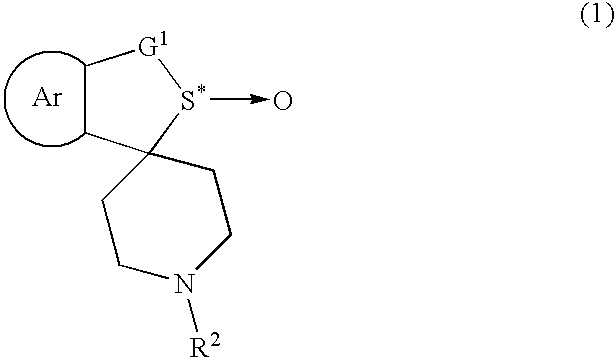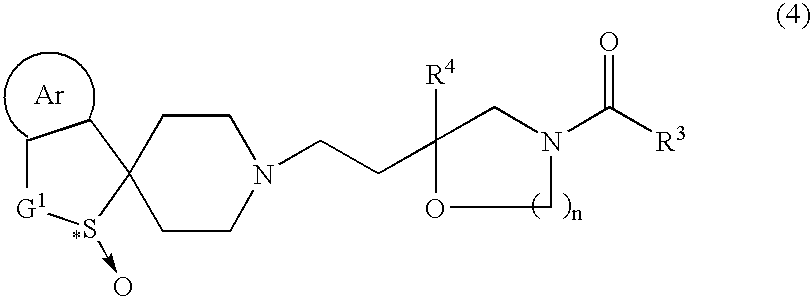Process for producing optically active sulfoxide
a technology of cyclic sulfoxide and process, which is applied in the direction of heterocyclic compound active ingredients, biocide, organic chemistry, etc., can solve the problems of method is also method is unsuitable industrial production process, etc., to achieve high yield and high enantiomeric excess
- Summary
- Abstract
- Description
- Claims
- Application Information
AI Technical Summary
Benefits of technology
Problems solved by technology
Method used
Image
Examples
example 1
tert-Butyl (2S)-spiro[benzo[c]thiophene-1(3H),4′-piperidine]-1′-carboxylate 2-oxide
[0132] Under a nitrogen atmosphere, 0.99 ml (3.23 mmol) of titanium (IV) isopropoxide was added dropwise to a mixed solution of 1.35 ml (6.45 mmol) of diisopropyl (−)-tartrate and 40 ml of chlorobenzene at room temperature. After this solution was stirred at room temperature for approximately 20 minutes, 0.25 ml (3.22 mmol) of isopropyl alcohol was added thereto at room temperature and the mixture was further stirred for approximately 10 minutes. After cooling it to −10° C. or lower, 5.00 g (16.2 mmol) of tert-butyl spiro[benzo[c]thiophene-1(3H),4′-piperidine]-1′-carboxylate were added thereto. A solution of 2.95 ml (17.7 mmol) of cumene hydroperoxide in 10 ml of chlorobenzene was added dropwise to the mixture at −10° C. or lower and the mixture was stirred at −10° C. for 5 hours. When the reaction mixture was analyzed by HPLC, the mixture was constituted by 86.7% tert-butyl (2S)-spiro[benzo[c]thioph...
example 2
(S)-((+))-Mandelic Acid Salt of (2S)-spiro[benzo[c]thiophene-1(3H),4′-piperidine]2-oxide
[0135] Under a nitrogen atmosphere, 74.4 g (243.5 mmol) of tert-butyl spiro[benzo[c]thiophene-1(3H),4′-piperidine]-1′-carboxylate and 525 ml of chlorobenzene were mixed and 22.8 g (97.4 mmol) of diisopropyl (−)-tartrate were further added thereto at room temperature. Then, 7.47 ml (24.3 mmol) of titanium (IV) isopropoxide were added dropwise thereto at room temperature and the mixture was stirred at the same temperature for approximately 20 minutes. 7.48 ml (97.3 mmol) of isopropyl alcohol were added thereto at room temperature and the mixture was further stirred for approximately 20 minutes. After cooling it to −10° C. or lower, a solution of 55.6 g (292.2 mmol) of cumene hydroperoxide in 150 ml of chlorobenzene was added dropwise thereto at −10° C. or lower and the mixture was stirred at −10° C. for 5 hours. When the reaction mixture was analyzed by HPLC, the mixture was constituted by 87.3% t...
example 3
Methyl (2S)-spiro[benzo[c]thiophene-1(3H),4′-piperidine]-1′-carboxylate 2-oxide
[0138] Under a nitrogen atmosphere, 0.198 ml (0.64 mmol) of titanium (IV) isopropoxide was added dropwise to a mixed solution of 0.27 ml (1.29 mmol) of diisopropyl (−)-tartrate and 9 ml of o-dichlorobenzene at room temperature. After the solution was stirred at room temperature for approximately 20 minutes, 49.5 μl (0.64 mmol) of isopropyl alcohol were added thereto at room temperature and the mixture was further stirred for approximately 10 minutes. After cooling it to −10° C. or lower, 0.85 g (3.22 mmol) of methyl spiro[benzo[c]thiophene-1(3H),4′-piperidine]-1′-carboxylate was added thereto. Then, a solution of 0.59 ml (3.54 mmol) of cumene hydroperoxide in 2 ml of o-dichlorobenzene was added dropwise thereto at −10° C. or lower. After the mixture was stirred at −10° C. for 5 hours, the reaction mixture was analyzed by HPLC, and the mixture was constituted by 84.7% methyl (2S)-spiro[benzo[c]thiophene-1...
PUM
| Property | Measurement | Unit |
|---|---|---|
| temperature | aaaaa | aaaaa |
| temperature | aaaaa | aaaaa |
| temperature | aaaaa | aaaaa |
Abstract
Description
Claims
Application Information
 Login to View More
Login to View More - R&D
- Intellectual Property
- Life Sciences
- Materials
- Tech Scout
- Unparalleled Data Quality
- Higher Quality Content
- 60% Fewer Hallucinations
Browse by: Latest US Patents, China's latest patents, Technical Efficacy Thesaurus, Application Domain, Technology Topic, Popular Technical Reports.
© 2025 PatSnap. All rights reserved.Legal|Privacy policy|Modern Slavery Act Transparency Statement|Sitemap|About US| Contact US: help@patsnap.com



